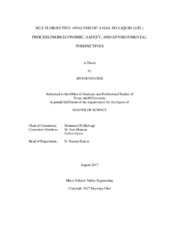| dc.description.abstract | One of the most important challenges facing chemical engineers today is developing more efficient processes that reduce the discharge of greenhouse gasses (GHG) and the usage of material and energy resources. Furthermore, industrial manufacturers are making major efforts to incorporate inherently safer design concepts when developing or retrofitting processes. With the recent discoveries of shale gas, there is a growing interest in monetization pathways that convert gas to chemicals and fuels. The Fisher-Tropsch gas-to-Liquid (GTL) process is regarded as a promising alternative to producing liquid transportation fuels. A typical GTL plant requires substantial mass, energy, and financial resources. The syngas production section, in particular, accounts for approximately 50-75% of the total capital costs and about 60-70% of the total energy requirements. Also, the GTL plants have several trains for the syngas production section to accommodate large-scale capacities. Focus on this work is to investigate possible improvements to the GTL process in two areas: 1) tailgas recycling and 2) lower steam-to-carbon (S/C) ratio for autothermal reforming (ATR). The results from these cases are analyzed in terms of cost, inherent safety, and environmental sustainability. Ultimately, the aim of this research is to support the decision makers in understanding the multi-objective insights and in using these insights to make better decisions in design and operation.
This study provides a comparative approach for four different operating cases from various perspectives: economics, inherent safety, and environmental sustainability. In the inherent safety analysis, a fire and explosion hazard analysis are used to choose the least hazardous material for a fuel. The release rate is estimated at the failure case in order to evaluate the degree of containment loss. For the environmental sustainability, the carbon efficiency of the overall process and CO2 emissions are evaluated. The operating conditions and results are validated against pilot test results from industry in order to verify the degree of carbon deposition during operation. The results are used to establish tradeoffs among the various objectives. | en |


